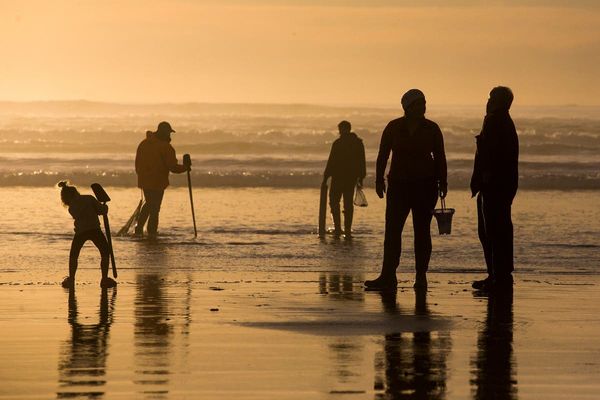
In Walcha, the locals say, the wind blows straight up from Cooma and clears the 800km distance in about two minutes flat. It’s that wind that has made it a prized site for renewable energy projects.
The northern inland New South Wales town is in the southernmost lobe of the New England Renewable Energy Zone (Rez), the northernmost of the five zones set up by the NSW government to cluster new wind and solar projects together for ease of storage and transmission.
One project in development to make use of all that Walcha wind is the Winterbourne windfarm, the majority stakeholder of which is Danish renewable energy company Vestas. The project has been in development since 2004 and the company says it hopes to start building in 2024.
The proposal involves building “up to 119” turbines with a maximum blade tip height of 230 metres across the north and east of the town. The proponents of the project say the turbines will be a boon to the region and its people, while opponents say it’s a risk to tourism, biodiversity and the town’s aesthetics.
It’s a familiar argument, repeated up and down the east coast under a wave of new windfarm developments.
Among the most vocal detractors is the former National party leader and New England MP, Barnaby Joyce, who has argued that the region should instead work to extend the life of its existing coal power stations until new nuclear technology is available. Joyce has found himself on the same side of at least some of the arguments with treechangers and local conservationists, concerned about the environmental impact of the proposed windfarm, and on the opposite side to a number of local farmers who see themselves on the frontline of climate change.
‘We need to diversify’
The Fletchers are one of the families willing to speak out in favour of Winterbourne. The land that’s been in their family since 1863 is slated to host some of the turbines.
Warwick Fletcher, who runs sheep and cattle, sees it as a chance for Walcha to be at the forefront of renewable energy development. It is a win-win for farmers, he says: the royalties from hosting turbines will be a stable income stream; and the switch to renewables will lessen the impact of the climate crisis.
“Our production is governed by rain,” Fletcher says. “We’ve had years where we had negative returns on assets, year in, year out. Everybody keeps telling us we can’t afford to rely on handouts – we need to diversify.”
For Warwick’s daughter, Holly, it is about future-proofing the farm.
“We know the effects of climate change are real,” she says. “The people in the bush experience it more than anyone else in the country.”

Walcha’s population of just over 3,000 is ageing. With younger workers forced to move away for employment, there’s less money in the town and fewer reasons to stay. The project comes with the promise of a $1m community development fund, with an additional $750,000 a year once the generators are turned on and a further $1,000 for every megawatt generated over 600MW. With a projected output of 700MW, that’s up to $850,000 a year for a town that sorely needs investment. Vestas also says the project will create up to 400 jobs during construction and 16 maintenance jobs once operational.
The town needs the money.
“The inequality [in Walcha] is incredible,” Fletcher says.
It’s not the only project in the area: the first stage of the 720MW New England solar farm at Uralla, 40km from Walcha, opened on Wednesday. Other communities are cashing in.
Fletcher is frustrated that Joyce, his local MP, and the National party, aren’t backing a project that is offering that level of financial support.
“How many Nationals in federal parliament?” Fletcher says. “There’s going to be less and less people in the bush to vote for them.”
An unlikely alliance of opponents
Most of the opponents to the windfarm are concerned about the impact it may have on threatened species, as well as concerns about construction, turbine height, end-of-life of disposal of blades, noise, and the appropriateness of the community consultation. Others, like Barnaby Joyce, just oppose windfarms in general.
Rachel and Cameron Greig are members of Voice For Walcha and are concerned about its proximity to Oxley Wild Rivers national park.
“Winterbourne’s [environmental impact statement] describes the concentration as 0.66 wedgetail eagles per hectare per hour,” Rachel says.
“At any other windfarm that they’ve got this measured for it goes from 0.11 to 0.44,” she says. “So it’s really one-and-a-half times higher than any other windfarms that they’ve mentioned. Wedgies get killed at these windfarms.”
Most of their concerns come directly from the Winterbourne proposal documents. The EIS states the project will also “result in the loss of up to 206.73 hectares of potential habitat” for koalas and “a significant residual impact is considered likely”.
The total cost of required environmental offsets will be $64.3m, the EIS states. The total cost of the project, Vestas says, will be $1.9bn.
“It’s going to lead to loss of habitat to threatened species, including koalas, quolls and gliders,” Rachel Greig says.

Cameron Greig argues that placing the turbines at the edge of the national park could potentially create an issue for aerial firefighting, by obstructing the bombers.
“With turbines against that area, they’ve lost a pretty crucial tool to get control of those areas – in a smoky environment or in low cloud, those areas just become no-fly zones,” he says.
The Rural Fire Service told Guardian Australia that wind turbines could be negotiated like any other obstacle. “Wind turbines are treated in the same way as other hazards across the landscape, such as power lines, radio or television transmission towers and mountains, all of which need to be taken into account in mission planning and by individual pilots,” a spokesperson said.
Both Joyce, who has a property at nearby Woolbrook, and the National party state member for Northern Tablelands, Adam Marshall, attended a Voice for Walcha meeting in January in opposition to the project. Walcha was previously in the state electorate for Tamworth, but will fall under Northern Tablelands in the redrawn electoral boundaries for the 25 March poll.
Marshall told the gathering the proposal contained “the very worst EIS I have ever, ever seen”.
Joyce repeated calls for nuclear reactors to replace ageing coal-fired generators, instead of wind, and asked locals to march on Canberra.
“I’m gonna tell you one thing: the [wind turbine] technology will be so out of date, it will be ridiculous. It will be antiquated,” Joyce told the crowd at the Walcha Bowling Club.
“Personally, I believe that nuclear power will be in, and it’ll be something that would fit in this room that will do the job of thousands of wind turbines.”

In a statement to Guardian Australia, Vestas says the company recognises “that change can be difficult and the transition away from fossil fuels to renewable energy involves regional areas like Walcha”.
It says it remains committed to engaging with the community openly and transparently.
The Walcha mayor, Eric Noakes, says the council has taken a “neutral stance” on the project, with “councillors for it, councillors against it”.
Noakes says the project has been “divisive” and he hopes the fault lines don’t run too deep. “We’ve always been a tight community – we’ve got to be a tight community to survive the tough times,” he says. “We’ll need our resilience as a community again one day.”







